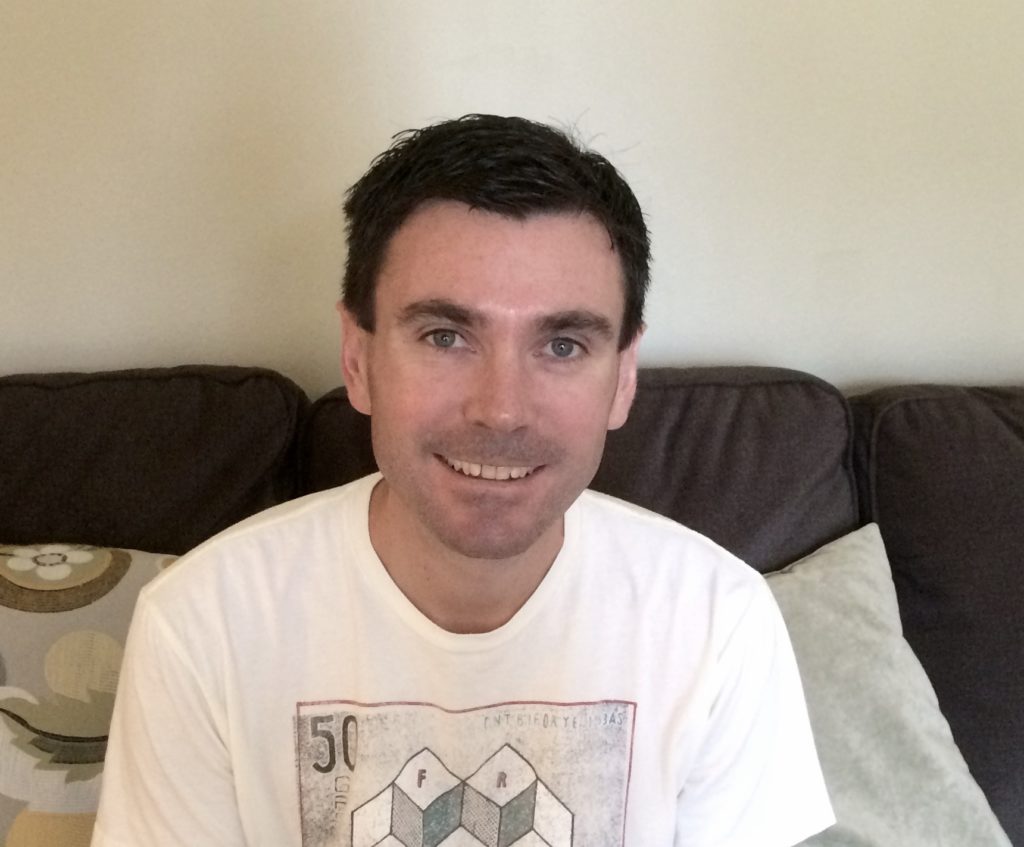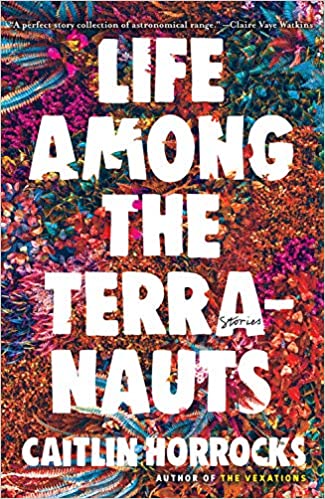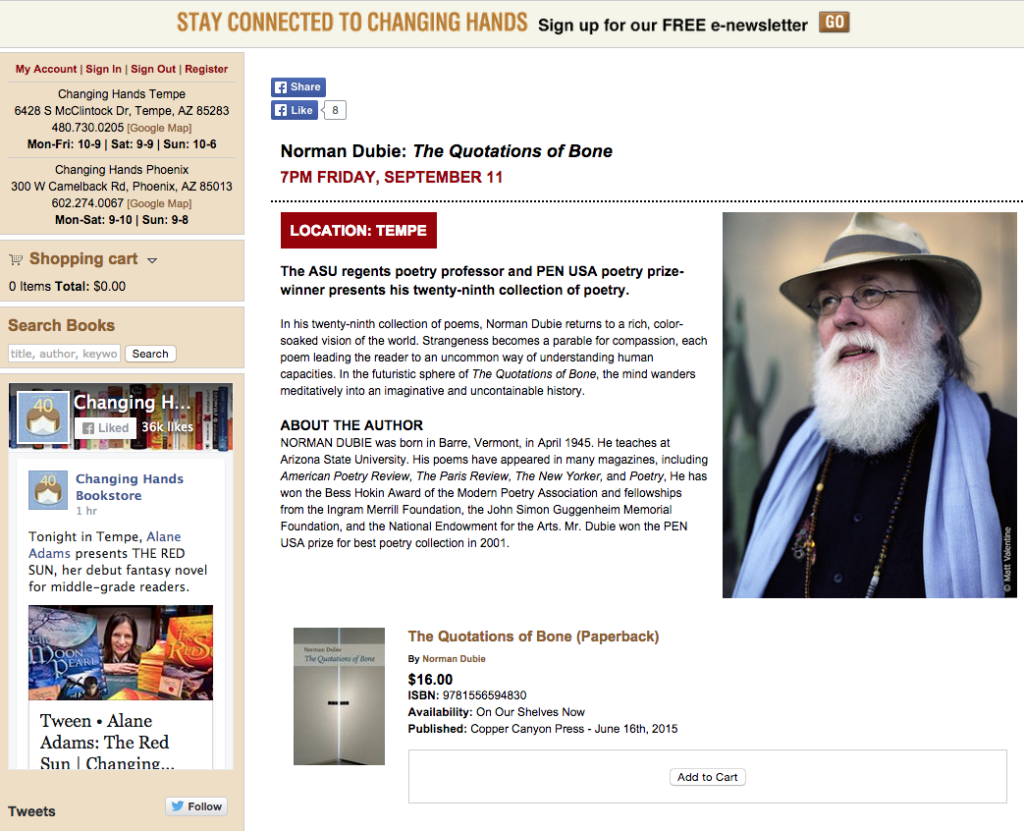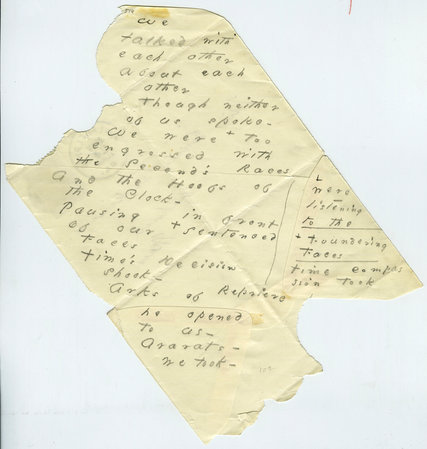 The finish line appeared before me like the gilded gate to some fabled city (only a slight exaggeration). In the recovery area I collected my medal and t-shirt, downed some Gatorade, reunited with my family, and now, a few blocks later, the Gatorade lay pooled by my running shoes. “Dad, it’s green,” my son pointed out. He was right. It looked like a vehicle with a bad radiator leak had just pulled away. My wife, realizing my state, went to fetch the car, so I leaned against the side of a building as my kids hovered around me on an overcast morning in Duluth. Race finishers and spectators strolled past, beginning the steep ascent from the harbor. They eyed the puddle of vomit, then me. Some understood my situation, I think, and some were confused or even repelled, but no one said anything. I herded the kids toward the far side of the alley, distancing us as though from the pooled blood at a crime scene.
The finish line appeared before me like the gilded gate to some fabled city (only a slight exaggeration). In the recovery area I collected my medal and t-shirt, downed some Gatorade, reunited with my family, and now, a few blocks later, the Gatorade lay pooled by my running shoes. “Dad, it’s green,” my son pointed out. He was right. It looked like a vehicle with a bad radiator leak had just pulled away. My wife, realizing my state, went to fetch the car, so I leaned against the side of a building as my kids hovered around me on an overcast morning in Duluth. Race finishers and spectators strolled past, beginning the steep ascent from the harbor. They eyed the puddle of vomit, then me. Some understood my situation, I think, and some were confused or even repelled, but no one said anything. I herded the kids toward the far side of the alley, distancing us as though from the pooled blood at a crime scene.
This was my second marathon. The first had been a more low-key affair in my home city, little more than an experiment. I just wanted to see if I could finish without walking. Duluth had been a lesson in humility. For my kids the episode in the alleyway remains a fond memory, and four years later they still bring it up, that time they watched their dad spew greenish gunk like a guy in a sci-fi film. That morning I dehydrated myself to the point of sickness in an effort to better the time from my first marathon, ultimately finishing fifteen seconds faster. Months of training, often in wind, rain, snow, sometimes on ice-sheeted sidewalks. Entry fees, hours of driving, hotel and food and gas expenditures, and a race that left me pondering the efficacy of an IV, all culminating in this. Fifteen seconds.
Since that overcast day I’ve run thirteen more marathons, and as many times I’ve vowed, publicly and privately, never to run another. “Yeah, right,” my wife always replies, smirking. The smirk is galling but justified. As of the writing of this, I’ve registered for two more marathons and am eyeing two more beyond that. My wife is mystified by my perpetual cycle of training and racing. She, a non-runner, would prefer her getaways adorned with palm trees, white sand, and a steady parade of rum drinks with little umbrellas in them. She does not care to spend her few allotted vacation days in Wichita or Fargo or Toledo (all great marathon cities). She’d like for us to sit on our deck on warm Saturday evenings and enjoy a beer or two without me worrying about how it might impact my training run the next morning.
It would probably surprise no one when I say I’m uncertain marathoning has led to greater contentment, happiness, a newfound kinship with the almighty, or any of that rigmarole. I can’t even characterize the races as fun. If fun is rolling surf and suntan oil, marathons are, at least sometimes, white-out frostbite-inducing blizzards. There’s the nausea, the dehydration. I’ve been chafed to the point of shower yowling. I’ve been bone tired and plagued by body aches. I’ve suffered IT Band syndrome, shin splints, plantar fasciitis. During my last race I looked down to realize I’d bled through my shoe, which I later found to have been caused by two ruptured blisters. My toenails have blackened like overripe bananas, though not until recently did I actually lose one. It’s difficult to reconcile the swell of pride I felt when the nail came off in my fingers. I was quick to show the kids, knowing they’d appreciate this grim development the same way they admired my Linda Blair routine in the Duluth alleyway.
The pain I felt was primarily physical, and while there were tricks—training, Bodyglide, compression socks, electrolyte drinks—to diminish the discomfort, there was no way to circumvent it. The last few miles of a marathon become a study in pain management. This pain is different in character than the feeling that accompanies a 5K or 10K. The miseries of those races are quick and brutal, flash fires. The marathon is a slow burn. Throughout the race you’ve been consuming water, Gatorade, and energy chews or gels. This liquefied sugar combo leaves your mouth filmed with a sticky, unpleasant residue. Condensed sweat leaves salt on your skin in wavering lines like an EKG printout. At mile fifteen or sixteen, your feet start to ache, or your toes, maybe your calves or quads, maybe all of the above. Your sunglasses are sweat-streaked. Your singlet clings to you. You can’t seem to quench your thirst. In your head you’ve been splitting the race into manageable sums. Six miles down, only twenty to go. Ten miles, I’m at double digits. Thirteen miles, the halfway point! Sixteen miles, only ten left. At twenty or twenty-one miles, the steps grow heavier, ponderous. A simple incline from pavement to curb can seem taxing. As you sailed through the opening miles, you read the funny signs held by scattered spectators and you smiled, full of nervous energy and goodwill toward man (and woman). You high-fived a couple kids. Now your eyes are too tired to pass smoothly over the landscape, and instead you catch lurching snapshots. A volunteer sweeping up empty cups. A dog patiently licking its hindquarters. A discarded banana peel. The awkward form of a passing runner. A policeman waving traffic past. You hear a song, and its refrain loops endlessly in your head. You fixate. Why’s that guy with the weird gait faster than me? Is this what it feels like when convicts escape from prison? Where’d that juggler come from? You develop tunnel vision, eyeing only the road ahead. It isn’t focus but self-preservation, the way sailors jettison excess items from a sinking vessel. The scattered spectators slide away, becoming immaterial, except for those who call out something to distract you, maybe the name printed on your bib, and you’re grateful for those few seconds of diversion. You observe everything from a couch in the black-walled depths of your skull. Whereas with out-of-body experiences you’re lifted skyward to observe yourself dispassionately, here you’re being tucked more deeply into yourself. Meanwhile your mind keeps firing paltry distress flares. Go ahead and stop, just for a minute, it’s okay. No one will hold it against you. There’ll be other races. Walk through this aid station, lie down in that grassy area over there, take off your shoes and socks, rub your feet, find a t-bone and some beer.
This is your mind’s subterfuge, and you’ve got to short-circuit it somehow. You start counting each breath, each footstep. You get to a hundred and start over. Numbers, just numbers. Instinctive. Steps stretch out over distance and time in some unknowable, constantly shifting equation. Stay upright, press forward. Endure. Then the finish line, hastily erected to remind you how arbitrary the whole thing is. The gates of the gilded city.
I tried holding certain thoughts at bay:
- The distance, arrived upon (incidentally) so the runners in the 1908 Olympics might pass Queen Alexandra in her regal box seat.
- The time it took to cover that distance, whether five hours or three hours or fast enough to qualify for Boston. Ultimately, what did it matter? There were so many who ran the event faster. Why push myself to near-collapse when the end result reeked of mediocrity and obscurity? Even the elite marathoners, all but a handful, barely eked out a living. It was not a sport that commanded a following but rather an irritation for those motorists who happened upon closed streets on a Sunday morning.
Adam Alter wrote a piece on long-distance runners that appeared in the December 2015 issue of The New Yorker. The question Alter hoped to answer, or at least investigate—the question I’d been asked repeatedly, by others and by myself—was “Why?” Why put yourself through it? And voluntarily, no less. Why pay money for the privilege? Why, when the most someone like myself could hope for was perhaps a small gift certificate or a plaque or a pint glass? What caught my attention in Alter’s piece was the distinction he drew between happiness—what he defined as “a positive, momentary emotional tone” (i.e. fleeting)—and meaningfulness, “the sense that one’s life has broad value and purpose.” Alter pointed out the arbitrary nature of running and the paradox of trying to find meaning in something so inherently meaningless. The conclusion he came to, with which I agree, was that the event itself didn’t have any inherent meaning. Meaningfulness came from making, pursuing, and (hopefully) attaining a goal. Runners are goal-oriented people. We are planners, as evidenced by our spreadsheets detailing proposed races. When our plans don’t work out, which in running is about ninety percent of the time, we make new ones.
As one of the runners in Alter’s article explained (and I paraphrase), the goal should be a bit scary if it’s worth trying. I will never argue that the local charity 5K is a cakewalk, but as I grew more serious about running, I found myself less anxious the night before such events. These were my gateway drugs, and I was building a tolerance. I needed something to mainline. The marathon was the new opiate, providing the requisite level of fear. I slept fitfully the night before a race and woke with butterflies in my stomach, barely able to choke down yogurt or a bagel. That anxiety has not diminished, and I think it’s because with marathons there are no guarantees of success. My times have fluctuated, sometimes wildly, along with the state of my body. I’ve finished marathons feeling tired but unscathed, and I’ve finished with blisters, aching muscles, and an overwhelming urge to splatter an alleyway with recycled Gatorade.
Maybe it’s thrill-seeking, a way to quicken the heart rate, an activity to be lumped in with snowboarding and bungee jumping and motorcycling. Maybe a midlife crisis. But pain is the word I keep dancing around. I say I run marathons because I like setting goals, I like training and competing, I enjoy feeling like an athlete even in middle age. I crave the anticipation of the event before me, the jittery feeling. But I’m not really scared of failure, I’m scared of hurting. And if I’m truly honest with myself, I don’t just fear pain: I crave it. There are those of us who’ve reached the point where the pulse of our lives has slowed to a rhythmic beat. Monthly paycheck, mortgage, a job that requires us to spend the bulk of our waking hours tethered to a monitor. We need a jolt of voltage to free us from the waking dream. We seek out pain because after awhile even pain trumps monotony. The pain tells us we’re alive.
I don’t know how many marathoners are fiction writers or poets, but I’m guessing there are plenty, Haruki Murakami being perhaps the most famous example. I keep returning to his What I Think About When I Think About Running when I need to see how another writer approaches this inward and socially dubious pastime (by which I mean running, although creative writing might also qualify). Maybe now in the age of social media it’s easier to stumble across the writing/distance-running set, but I don’t think as a rule we do much self-promotion. While we like being patted on the back for our accomplishments, that’s not why we take up such sports. Most of us will never climb any podiums, but we keep toiling regardless, often under the apprehension we will fail (“Fail again. Fail better.”) but resolved to persevere anyway.
In fact, those looking for instant recognition are probably going to drift toward other pursuits, because the ones I’m describing here require long, slow trudging in isolated terrains. There are no YouTube shortcuts to overnight success. These are sports that take years, with progress coming in fits and starts. A story is taken by a prestigious journal and we think we’re set for literary stardom, only to endure twenty subsequent rejections and a plummet back to earth, back to the day job and the bills and the crippling self-doubt. The same is true of running. We set a personal record in March and expect our upcoming season to be filled with more of the same. Then we run a couple more races and find ourselves unaccountably slower. Then we over-train and pull a muscle. We can’t measure our success against other runners any more than we can determine the quality of our writing by the external reactions to it. We find our rewards in the process. I’ve come to enjoy the training, the lead-up, more than the race itself, to the point where the finish feels like a letdown and the week or two afterward I slip into a funk. In much the same way, the pleasure of writing for me comes with drafting and revising. Once the story or poem leaves my desk, making its way into the hands of editors, I’ve already squeezed every drop of pleasure from it. After the long courtship, I’ve lost interest, which is the way it must be.
And so I return to the question: Why do it? Why these particular pursuits, story writing and marathon running? Why, when success is so illusory? Why, when the apprenticeship takes years? Decades? When there’s no certainty you’ll ever master your craft? It all seems masochistic and a bit antisocial. The long, solitary runs; the hours spent at the keyboard while your loved ones are elsewhere.
I have no universal answers and can only attempt to describe my own mind. I lead what is in many ways a clouded existence. The work I perform at my day job is oftentimes unfocused. I’m distracted by the song playing on my headphones or the email I just received or the coworker stopping by to talk about his aphid problem or the latest Marvel movie. My home life is more of the same. The dishwasher needs to be loaded, the dog tore a hole in the window screen, my son is waiting for me to take him to baseball practice, my daughter is asking to play at the neighbor’s. Meanwhile I’m checking my Twitter feed and the Times headlines and fixing myself some cereal and wondering what I’m going to stream on TV later.
While running I might listen to a book or some music, but mostly I’m focused on my breathing, my form, my pace, to the extent that if you asked me what I thought about during my workout I probably wouldn’t be able to recall. It’s a mind-clearing exercise, spirituality without the handbooks and other paraphernalia. This becomes even more true in marathons, where these tertiary concerns slip away. In so many aspects of my life, I’m expending only a portion of myself, but with marathons and writing, the effort is absolute. It’s gratifying to finish a race and be able to say honestly that you pushed yourself to your limits. We often claim we did our best, often to salve the sting of failure, but how often is it the truth? In this sedentary age, where the act of walking to the vending machine seems greater than the reward, full-tilt effort is a rarity.
Writing offers that same opportunity. Whereas no piece of writing is perfect, just as no race is, there’s a thrilling sense of accomplishment when we’ve worked a story or poem to the point of comma-quibbling, brushing against the ceiling of our potential. I purposely use adjectives like “gratifying” rather than “fun” to describe the process. It’s mentally taxing, after all, but by that same token, I’ve always cringed when I’ve heard it called “work.” Anyone who’s spent even a single day laying sod or pouring concrete would agree that typing on a keyboard is something altogether different. If we wanted fleeting happiness, we’d go jet-skiing. When we write, we’re seeking what Alter described in relation to ultra-runners: meaningfulness, the ongoing passions and pursuits that shape our lives. Reaching the limits of our talents can be depressing, but only when we allow ourselves to gauge our efforts in relation to other people.
I avoid running groups and clubs, preferring the untethered feeling of solitary runs, where there’s no need to match anyone else’s pace or worry about making small talk or obsess about how loudly I’m breathing. In running as in writing, there is generally no collaboration. We might run with others from time to time, but the work we do is our own, just as with writing, where the ideas and the execution are ours alone. This increases the fear of failure because we’re solely accountable. Many teachers ask their students, with regard to a story or poem, what’s at stake. I don’t know that every piece of writing needs to answer this question, but I do imagine there should be enough danger in a good story or poem to scare its writer a little, a jittery feeling as the final sentences come about, the same way a marathoner feels on race morning. When we’re young, the risks occur naturally, when our relationships and financial standing and sense of self and burgeoning careers are all teetering. Writing isn’t a pleasant diversion or a habit formed over many years, like a callous. More often it’s the inflatable life vest on the plummeting airliner, a means of surviving in a world, adulthood, that is still largely uncharted. It’s a way of focusing, like counting to a hundred over and over to numb the pain that accompanies the final miles of a marathon.
If we’re fortunate, privileged, we might start to find what we’re seeking—a safe environment, a companion, steady work, health insurance—and the ground on which we stand becomes firmer. The uncertainty that characterized our youth starts to evaporate, but we keep writing, perhaps seeing it as a way to make money (yes, we’re still naïve) or advance our careers or because we’re compelled or because it’s something we’ve done ever since we were kids composing stories by hand in pencil, with great care, on lined sheets of paper. We send our most polished work to little magazines, ever hopeful. But here the purity of the act—whether putting words down on paper or running as fast as possible—gives way to the seeming randomness of the larger world. The arbitrary nature of the submission process can be maddening. Our best story is rejected by a third-tier journal only to be accepted later by a first-tier one. We send a batch of poems to an editor who takes the worst while declining the others. We vacillate between condemnation of the editor (obviously clueless!) and dejection over the incompetence of our own work. Maybe we’re the clueless one. Though I’ve tried to brush aside such judgments, considering them the opinions of editors whose tastes simply didn’t jibe with mine, I’ll admit they’ve had a cumulative effect on me, a wearying, calcifying effect. Maybe it’s just the accretion of so many rejections, but they’ve come to seem like stones in a wall separating me from the pleasure of writing. I’ve ignored my own advice to tune out the noise.
Even though the distances are arbitrary, there’s a truth to running. Each competitor in a given race must cover the same ground, so if someone beats you it’s not because of a third-party espousing his tastes or pushing an agenda, it’s because that runner was faster. I appreciate the simplicity in that. There are no referees interpreting rules, no coaches playing favorites, just sweaty folks straining for the finish line. It’s fair, it’s democratic. Effort prevails. I think this is why I find myself spending more and more time these days browsing running websites and magazines rather than literary ones. I’m more careful not to skip a track workout than a writing session. I’ve grown tired of watching writers jockey for position and trade favors and flatter and attempt to commodify something that isn’t much of a commodity. Running is what holds me aloft these days while writing feels at times like the ballast, the chore. I’m searching for a way to make it new and fun again, a way to filter the outside expectations, because there aren’t any, not really.





 Today we are pleased to announce that future contributor Rebecca Hazelton has been recently featured in The New Yorker. Rebecca’s poem
Today we are pleased to announce that future contributor Rebecca Hazelton has been recently featured in The New Yorker. Rebecca’s poem 




